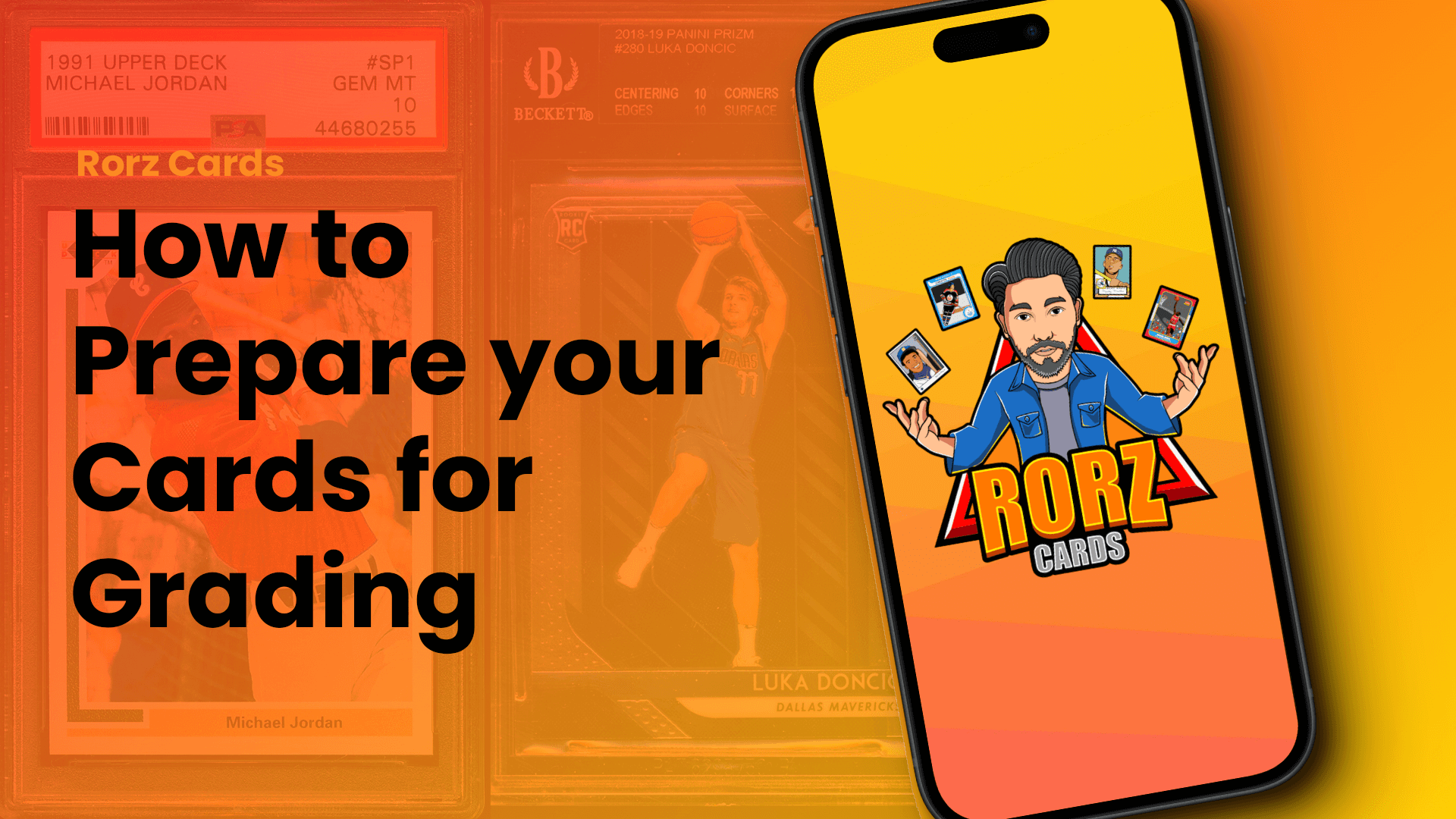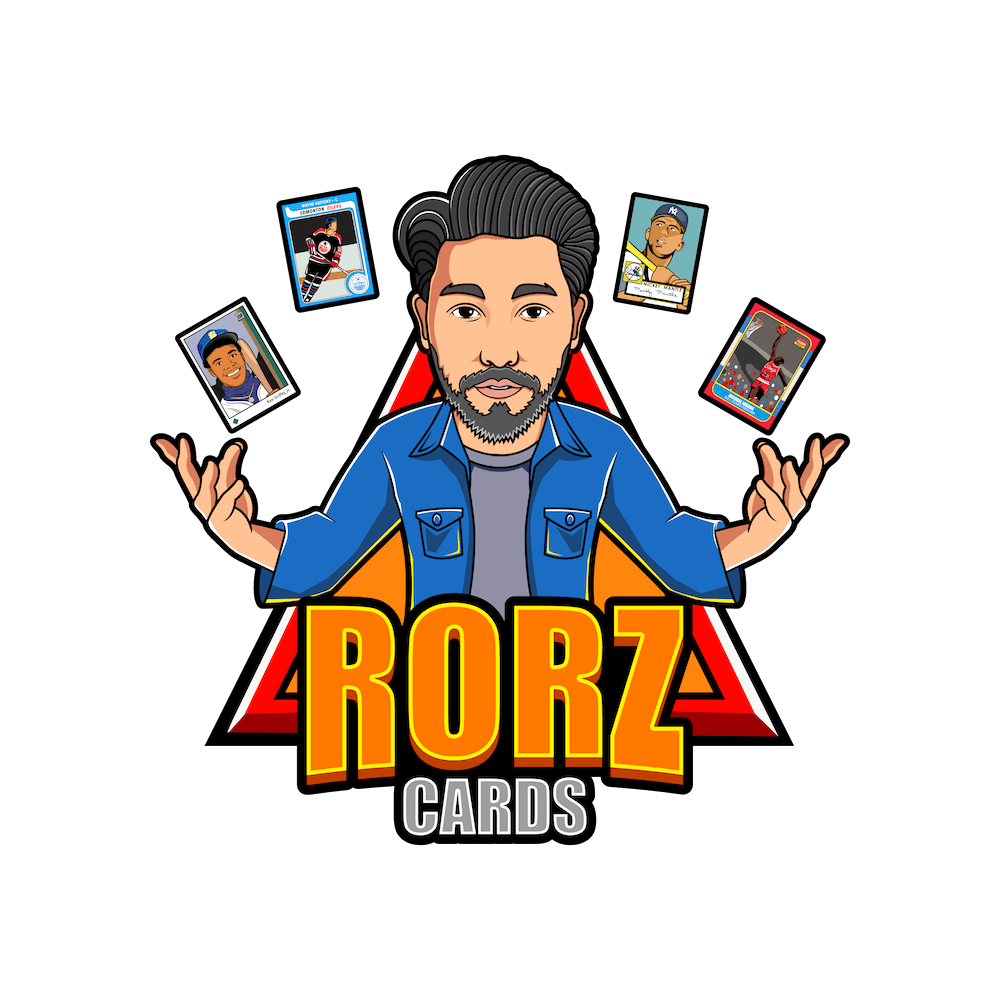
This post is part of a larger series called How To Grade Sports Cards – The Best Step-By-Step Guide. Be sure to check out the entire guide!
Table of Contents
When submitting cards for grading, the basic card preparation is to wipe down each card with a microfibre cloth, then carefully place the card in a penny sleeve then semi-rigid card holder. Nowadays though, collectors want and even need to go a step further to make sure their sports cards look their best during grading. Preparation then also includes what we call card cleaning.
Card cleaning is a complex AND controversial topic. Some card collectors are very against any sort of card cleaning and are vocal about it. Others are more accepting. The spectrum is wide.
In this article, we’ll dive into tips and tricks to prepare (eg. clean) your sports cards for submitting for grading. Some techniques will be very basic and surface-level, such as wiping down cards with a microfibre cloth. Other techniques will be more targeted at correcting specific types of flaws using a variety of tools.
While I personally use Kurt’s Card Care as my go-to card prep kit, there are other options out there, too. We’ll also use other tools easily found around your home, such as blue painters tape.
THIS ARTICLE IS A WORK IN PROGRESS.
Basic preparation
Wiping down your sports cards
Works for both paper and Chrome cards.
Take a microfibre cloth and gently wipe down the entire surface of the card. The goal here is to remove any dust and debris from the card as well as remove finger prints and smudges.
[TODO: image of me wiping down card with microfibre cloth]
While many collectors will use the sort of microfibre cloth that’s used for cleaning your eyeglasses lenses, I prefer these clothes.
Protecting your sports cards
Recommended supplies for packaging and shipping cards
- Penny sleeves (I recommend Ultra Pro Standard penny sleeves)
- Semi-rigid card holders (I recommend Cardboard Gold Card Saver 1 semi-rigid card holderss
Each card should be penny sleeved and inserted into a semi-rigid card holder prior to packaging and shipping your cards to the grading company.
Should you use top loaders?
No. The grading companies are unanimous in their recommendation that you use semi-rigid card holders instead of top loaders. There’s this incorrect belief that this is because the grading companies cut your card out of the semi-rigid sleeve. It’s actually because cards are much more secure in semi-rigid card holders than top loaders. While top loaders are great for storing and protecting cards AT REST, semi-rigid card holders are better for storing and protecting cards DURING MOVEMENT.
What about blue painters tape?
No, I personally don’t think its necessary to use painters tape on each Card Saver 1. And in fact, I think using painters tape can risk damaging your cards. When the tape is removed, the card could bend or finger nails could press through the Card Saver 1 and leave a mark, especially on softer more impressionable cards like foil cards.
What about team bags?
Optional. I personally do not use team bags or graded card sleeves when shipping cards for grading.
This is the end of the basic preparation when submitting your cards for grading. If you’re happy with how your cards look, move onto How to Ship Cards for Grading: Ensure Your Cards Get There Safely and Securely. Otherwise, scroll down for some advanced card cleaning techniques.
Advanced card cleaning techniques
Intro: Paper vs. Chrome cards
The materials your sports cards are made of and coated with will affect how you can clean your cards. With “paper” cards, eg. your vintage cards or non-Chrome Topps, Bowman or Upper Deck cards, you won’t be able to use polish at all and you’ll be limited on how much you can use cleaner.
On the other hand, with modern Chromium cards like Topps Chrome and Panini Prizm, perhaps your most used tool will be your polish.
Consider what sort of cards you have when scrolling through the techniques described below.
Setting up your workspace
I recommend using a thin sheet of foam stock as your workspace. When you’re wiping down your cards or polishing them, they’ll be resting on the foam to avoid the risk of scratches.
[TODO: image of foam sheet to come soon]
Kurt’s Card Care comes with a foam sheet you can use. I personally buy larger foam sheets on Amazon, then cut them down as needed.
I also try to avoid touching my cards while cleaning them as much as possible. To do this, I use a penny sleeve placed over a part of the card as a buffer between my finger and the card surface. My fingers press down on the penny sleeve in order to keep the card in place while I wipe and polish. This avoids finger prints and other oils from my hand ending up on the card surface.
[TODO: image of penny sleeve over card to come soon]
Then, to pick up the card off the foam sheet, I use my fingers to bend the foam sheet which lifts the edges of the card off the surface and I can grab the edges without touching the surface itself.
Removing surface scratches, fingerprints and other imperfections
Works for Chrome cards.
Use a polish applicator stick to gently apply card polish to the card. Then continue to brush the polish over the affected part of the card in a circular motion.
[TODO: image of applying polish to card]
With your microfibre cloth, gently wipe away the polish. No need to use force. Just let the cloth wipe the polish away effortlessly until the card shines. Fingerprints and smudges will be removed very easily. Other residues might require a repeat application.
[TODO: image of wiping away polish with microfibre cloth]
Examine the card. If the scratch and/or imperfection persists, try polishing again.
Ultimately, scratches are tough and you may not be able to fully remove them.
Removing edge fibres
Works for paper and Chrome cards.
Take a length of blue painters tape and make a circular loop of it that fits over a couple of your fingers.
[TODO: image of fingers wrapped with blue painters tape]
While holding the card in one hand, take the taped fingers of your other hand and gently press the tape down onto the edge of the card. Then pull the tape away from the card.
[TODO: image of dabbing card with painters tape]
If you look at the tape, you might see some white card fibres that have transferred from the card to the tape.
[TODO: image of fibres on painters tape]
Repeat this process wherever there are any loose fibres hanging off the edge of the card.
When you’re finished, if there are any persistent fibres, you can use either your finger or the edge tool in Kurt’s Card Care Kit to press down those fibres back into the edge of the card.
Fixing corner and edge dents
Works for paper cards. Can work for Chrome cards too, in some situations.
It may be counter-intuitive, but to fix edge dents, you have to work on the on the other side of the card. For example, if the front left edge has a dent, you’ll need to flip the card over and work on the back side of that dent.
[TODO: image of dent]
Using a straw, breath warm air through the straw and onto the card surface. You just want to add a little moisture to the surface. Cover the area with a penny sleeve.
[TODO: image of blowing straw onto card]
Using the edge tool, gently press into the backside of the dent so that you’re pushing the card stock down into the foam. In order to “push out” the dent on the other side, you need to “press into” the back of the dent. Results may vary.
[TODO: image of using edge tool]
If the dent isn’t gone yet, place the card into an oversized penny sleeve, perhaps 4″ x 6″ sized. Then sandwich the card/penny sleeve in between two plexiglass sheets. You can then use plastic clips to hold the plexiglass sheets in place, which will gently apply force to the area where the dent is/was. Leave the card in that position for a few days.
[TODO: image of card in plexiglass]
What not to fix
Paper card with a color border? Don’t try to remove loose card stock fibres. There’s a good chance you’ll remove some of the color border, too.
[TODO: image of black border card]
Next, move onto Chapter 4: How to Ship Cards for Grading: Ensure Your Cards Get There Safely and Securely.






Leave a Reply